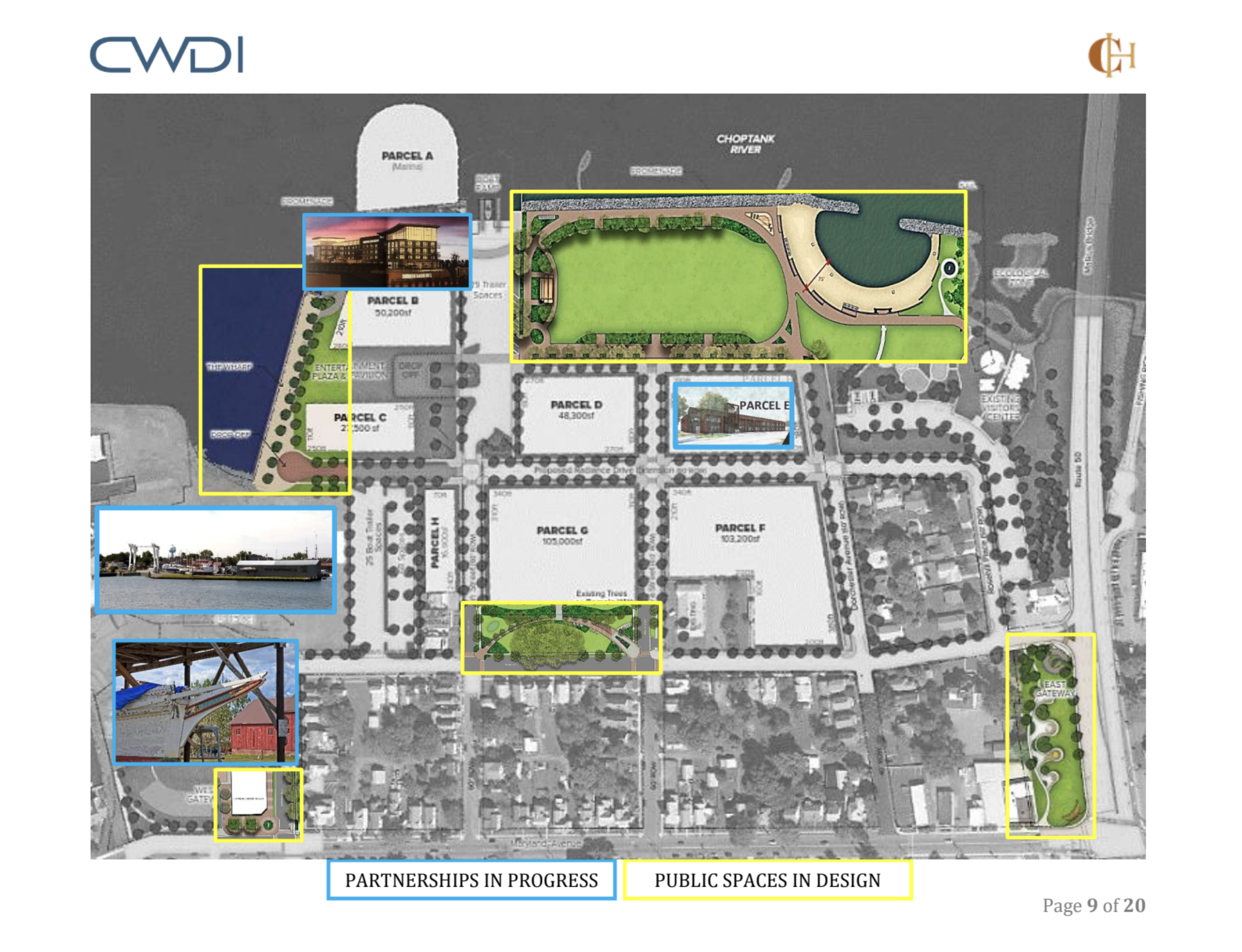
Harboring Plans for Cambridge
A major Cambridge re-development on the banks of the Choptank River is receiving a lot of attention of late as various Dorchester County officials and Cambridge Waterfront Development Incorporated (CWDI) seek consensus on the next steps for Cambridge Harbor—an ambitious project that will reimagine the waterfront space and old Cambridge hospital site just west of Sailwinds Park.
Easily visible from the Choptank River bridge, Cambridge Harbor has the potential to serve as a front porch for Cambridge, welcoming people from the water and attracting them downtown. Projects like this represent immense opportunity for a community, offering both a clean-slate to re-envision a large section of real estate and a chance to build a foundation on which the future economic and environmental health of a community can stand for decades. Of course, challenges certainly exist in Cambridge, as they would anywhere. How do officials assess viability? What mechanisms can be used to guide decision making? What are some of the innovative financing mechanisms that can help bridge the financial gap and take projects from imagination to reality?
Cambridge has worked for decades to redevelop their valuable waterfront area but plans have changed radically over the years. CWDI, a nonprofit formed by the City of Cambridge, Dorchester County, and the State of Maryland, is working to develop the Cambridge waterfront in partnership with the community in an effort to “create and sustainably maintain Cambridge Harbor as an inviting, accessible, active, and enjoyable place to live, work, play and visit.”
Cambridge’s original vision was for an 11-acre project, but now plans have expanded dramatically. CWDI Executive Director Matt Leonard pointed out at the most recent public meeting that the demolition of Dorchester General Hospital has been a “game-changer,” almost quadrupling the project’s potential footprint. Now CWDI has envisioned a 42-acre mixed use development, comprised of a 100-room boutique hotel, 240 residential units, 30,000 square feet of retail, an expanded marina, and a 750-space parking lot. In this current iteration, every single parcel of waterfront is reserved for seven acres of public riverside open space.
“The waterfront has always been an important part of Cambridge’s identity and cultural history. This design celebrates and preserves the rich maritime heritage that makes the area so special.”
— Carol Bean, Land Use and Policy Manager, ESLC

The vision is generally consistent with development projects that ESLC has supported in the past. The Cambridge Harbor would be connected, walkable, and mixed-use, with publicly accessible open space. Not only does reserving the entirety of the waterfront for open space provide scenic value and tremendous public access to the water, it also provides opportunities to responsibly steward the Choptank shoreline. Protecting the waterfront will make room for future mitigation measures and accommodate anticipated sea level rise which would otherwise pose threats to both the newly developed areas and the city blocks beyond. Careful planning is also important for less tangible reasons. “The waterfront has always been an important part of Cambridge’s identity and cultural history. This design celebrates and preserves the rich maritime heritage that makes the area so special” said Carol Bean, ESLC’s Land Use and Policy Manager.
As ideal as the new plan sounds, moving development away from the direct waterfront also creates significant financing challenges. Too much public space can sacrifice investors and risk the economic sustainability of a project. Too little public space leaves a hole in the development plan that will be impossible to fix later on. Still, over the course of decades, two things have remained clear. 1: The community wants the waterfront to be publicly accessible. 2: That same community is ultimately in charge.
It is essential that local residents and community organizations remain in control, continuing to be involved in the planning and decision-making process to ensure the project reflects other larger community priorities and values. One of those other large key considerations is how this development will impact the downtown district. Done right, Cambridge Harbor will serve as a gateway bringing needed economic development to downtown Cambridge, but such success will not happen by default. Cambridge has worked hard to steadily reinvigorate the downtown business district and any major new project must ensure that it compliments these efforts rather than running contrary.
It is important to the city of Cambridge, Dorchester County, and the entire region that Cambridge gets this right. As various entities navigate the path forward for Cambridge Harbor, ESLC looks forward to engaging in the most helpful way possible to share resources and build upon our past partnerships in the region to assist with developing the best possible iteration of this exciting waterfront development.
ESLC is currently collaborating with Urban 3 on a project to compare property tax data with investments for public services to create a measurement called “value per acre” (VPA). This measurement is a tool that local governments can use to better understand their return on investment on development projects. ESLC plans to share the results of this study with the community, local officials, and CWDI. In the meantime, community members can continue to advocate for best use of the property by attending the next CWDI public board meeting, scheduled for Wednesday May 22nd.


